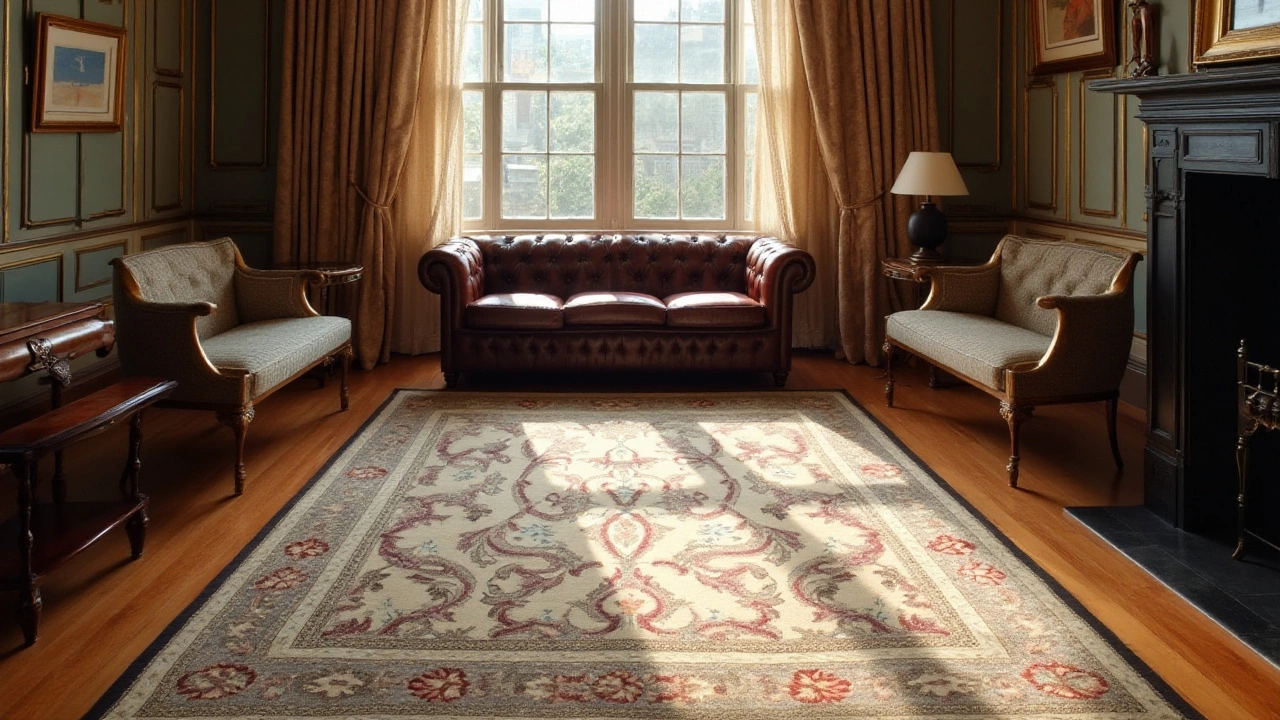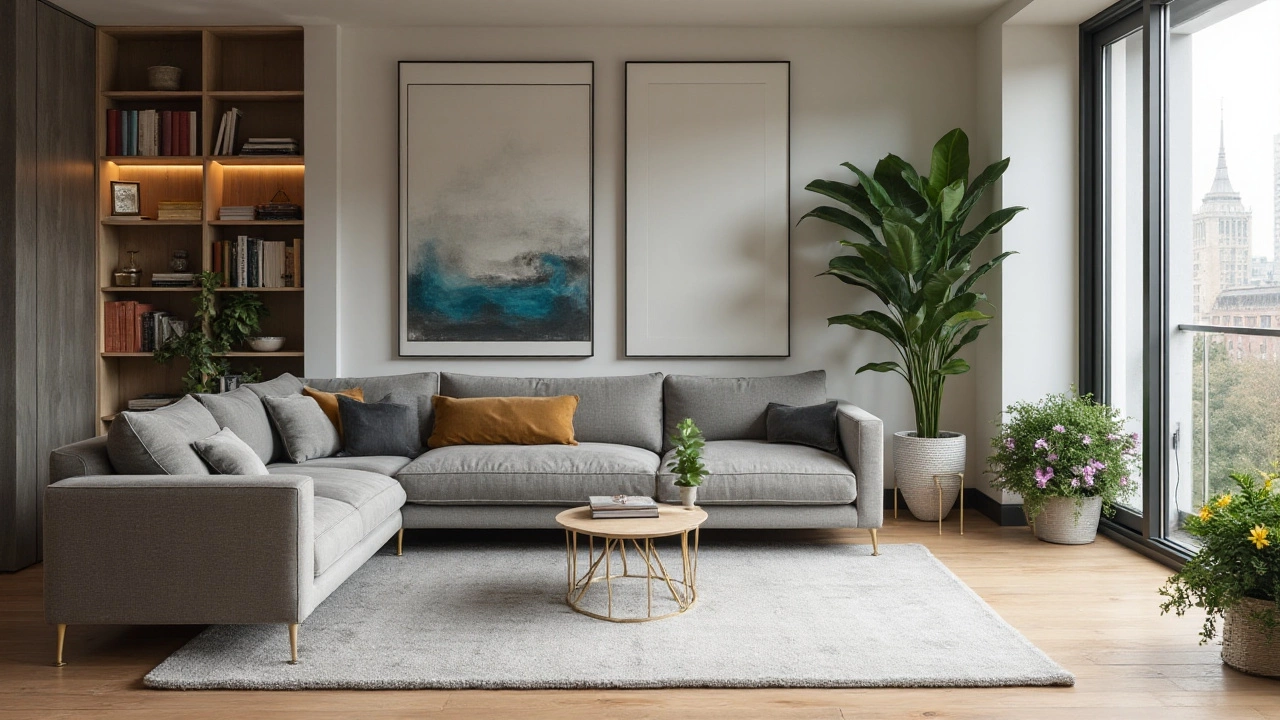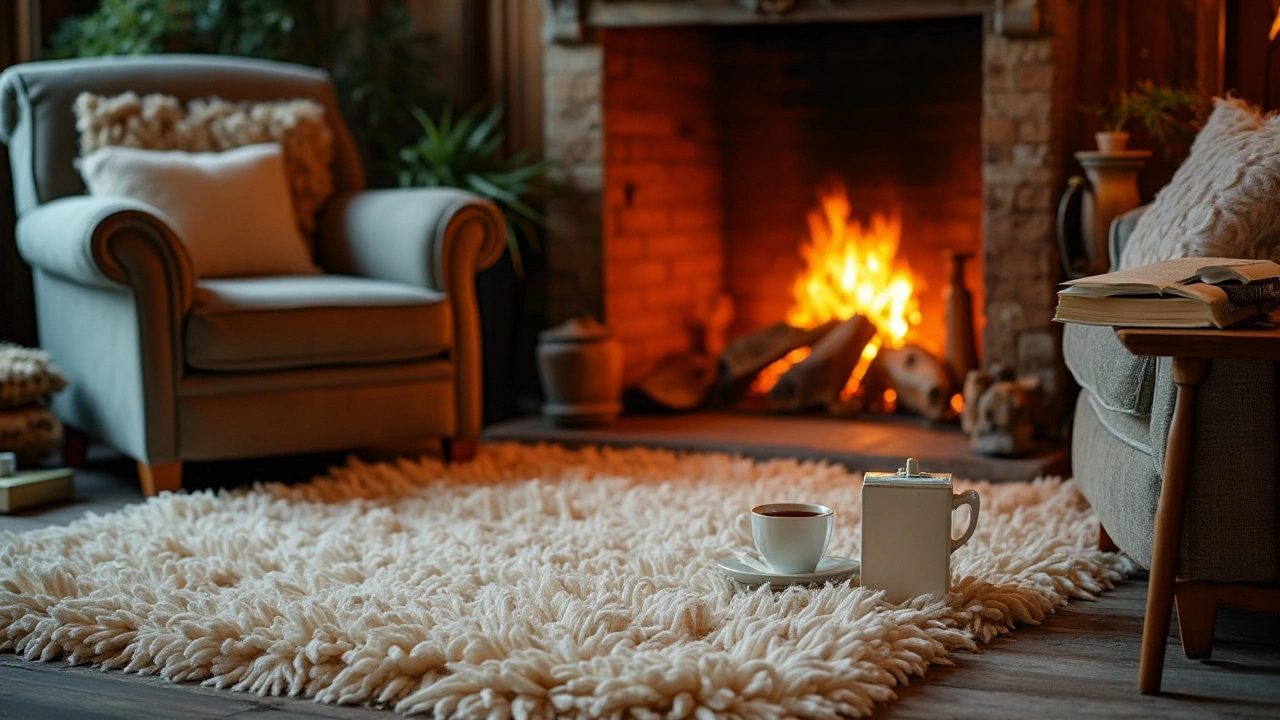Rugs transform a space, turning a house into a home with their inviting textures and warmth. However, with countless options available, how does one determine the most comfortable rug to tread upon?
Exploring the world of rugs involves understanding various materials and designs. From soft, fluffy shags that invite feet to sink in, to durable wool rugs that bring timeless elegance, there's something special about each type. In this article, we'll navigate through different rug options, discuss how to assess their comfort, and offer insights to help you make an informed decision for your home.
Whether it's for your cozy living room or a playful children's area, the right rug not only enhances aesthetics but also provides unmatched comfort. Let's dive in and find the perfect fit for your floors!
- Understanding Rug Materials
- The Role of Pile Height and Density
- Best Rugs for Cozy Living Areas
- Choosing Rugs for Children's Rooms
- Rug Maintenance for Optimal Comfort
Understanding Rug Materials
Choosing the right rug for your home is akin to embarking on a journey through textiles, where each material tells a story of its own. Materials play a critical role in defining a rug's texture, durability, and, most importantly, comfort. Each type offers a unique feel and ambiance, making the selection process both exciting and daunting. From the opulence of silk to the rustic charm of jute, rug materials possess qualities that can transform any space, bringing warmth and personality to your interiors.
When stepping into a room, rugs are the tactile elements that we physically engage with, and understanding their materials is key to finding the right fit for your home. Wool, known for its plush and insulating properties, is a perennial favorite. It's not only resilient but also naturally flame-resistant, offering peace of mind alongside comfort. Cotton rugs, on the other hand, are lightweight, versatile, and often machine-washable, making them a practical choice for high-traffic areas or homes with children and pets. Rug choices needn't be limited either, as synthetic fibers like polypropylene and nylon are engineered for durability and stain resistance, offering cost-effective solutions without compromising on aesthetics.
For those seeking eco-friendly options, natural fiber rugs such as sisal, jute, or seagrass are gaining popularity. These materials bring an organic texture to floors, although they may lack the plushness of traditional wool or cotton. Such textures are particularly appealing in coastal or rustic-themed interiors. Bamboo silk, a newer entrant, combines the sustainability of bamboo with the sumptuousness of silk, creating a luxurious yet conscientious floor covering. According to interior designer Jane Druker, "The material of a rug should resonate with the lifestyle it supports, balancing beauty with functionality."
Sensation underfoot is not the only consideration; the visual and tactile appeal of a rug can enhance the emotional warmth of a home. Wool's naturally crimped fibers lend rugs their characteristic springiness and softness, offering an inviting cushion for tired feet. Cotton, while not as plush, provides a visually appealing flat-woven texture that can brighten space. Silk, although often high-maintenance, is unmatched in sheen and sophistication, perfect for rooms where luxury is paramount. Synthetic options like polyester might lack some natural charm but make up for it with vivid colors and intricate designs.
To assist in the decision-making process, it may be helpful to weigh key factors in a concise format:
| Material | Benefits | Considerations |
|---|---|---|
| Wool | Soft, durable, flame-resistant | Higher cost, maintenance needed |
| Cotton | Versatile, easy care | Less plush, prone to wear |
| Jute/Sisal | Eco-friendly, unique texture | Rough, limited color schemes |
| Polypropylene | Stain-resistant, affordable | Less natural appearance |
Making an informed choice involves not just understanding where a rug will be placed but considering who will use it and how. Households with kids might lean toward washable, resilient options like cotton blends or synthetics, while a couple with a penchant for luxury might indulge in silk or high-grade wool. Rugs more than mere decor; they are foundational elements creating a lived-in feeling, seamlessly uniting style, function, and comfort.
The Role of Pile Height and Density
When diving into the world of rugs, the concepts of pile height and density play a pivotal role in determining the level of comfort a rug offers. Understanding these two elements can help you make a more informed choice when searching for that perfect comfortable rug to complement your home décor. Pile height refers to the length of fibers, while density indicates how closely these fibers are packed together. Together, these factors define not only the feel of the rug beneath your feet but also its durability and maintenance needs. A plush rug with higher pile and dense construction often equates to that luxurious sinking sensation many adore, though it can be more challenging to clean compared to low-pile options.
Higher pile rugs, such as shaggy varieties, have fibers that can reach up to 50mm in height, giving them that characteristic soft and lush texture. These rugs are perfect for areas where comfort is prioritized, like living rooms or bedrooms. On the other hand, low-pile rugs, typically with fibers up to 6mm, provide a cozier footprint ideal for high-traffic areas, as their tight weave makes them more resistant to wear and tear and easier to clean. There is an interesting interplay between pile height and density—while a thick rug generally offers more cushion, a denser weave ensures the fibers stand firm, allowing the rug to maintain its plushness over time.
The intersection of pile height and density isn't solely a technical consideration; it's an artistic one too. Carpets with varied pile heights can create textures and patterns that add character to any room, transforming ordinary spaces into engaging environments. It's also worth noting that different cultures have distinct rug-making traditions emphasizing various pile and density levels. Persian rugs, for example, often boast intricate patterns achieved with dense double knots. These result in a luxurious but sturdy feel underfoot, celebrated for its artistic richness and durability. According to an expert from Good Housekeeping, "The key to a rug's comfort isn't just in its softness but in the resilience and balance offered by the right pile and density combination."
Visual and tactile experiences also play a huge part. Higher pile rugs tend to have that lavish feel and can dampen noise, creating a quieter ambiance—perfect for areas where serenity is desired. Meanwhile, dense low-pile rugs excel in providing stable footing, making them preferred choices in places where slip resistance might be a concern, such as staircases or kitchen areas. The importance of these attributes connects deeply with personal preferences and the specific needs of different household spaces. Whether your choice leans towards the overarching warmth of a thick, feathery rug or the classic, clean look of a compact, dense piece, understanding the role of pile height and density will steer you closer to selecting the most comfortable rug for your daily life.
To put things into perspective, density can be illustrated through a simple comparison. Consider that a standard meter-sized area of a rug might contain anywhere between 100,000 to 450,000 points or knots. This spectrum helps identify where a specific rug lands in terms of plushness versus firmness, significantly impacting the decorative scheme of your space as well. The right blend of pile height and density can effortlessly accentuate any room's existing aesthetic while ensuring the rug feels just as indulgent as it looks. This relationship between technicality and artistry showcases the versatile nature of rugs and enhances their role as essential elements in setting the tone of cozy interiors.

Best Rugs for Cozy Living Areas
When it comes to creating a sanctuary within the heart of your home, few elements matter as much as a comfortable rug. The living area is a space where the family converges, where friends are entertained, and where moments of relaxation unwind. The right choice in home decor can elevate this space to an unparalleled level of coziness. It's not just about aesthetics; it’s about the tactile pleasure of stepping onto something soft, inviting, and warm. A cozy rug can significantly enhance the feel of your living room, making it a go-to area both in winter and when the evenings get a bit chilly.
One popular choice is the plush, high-pile rug, often known as a shag rug. These have been a staple in living rooms for decades and continue to enjoy popularity for their luxuriously soft textures. They’re great insulators, holding heat superbly and making them ideal for the UK’s cooler climate. The long fibers offer that sink-in comfort that makes you want to walk about barefoot, savoring every step. Maintenance requires a bit more attention due to their length, as they tend to trap debris, but with regular vacuuming and a deep clean once in a while, these rugs remain a comfortable option.
Wool rugs are another fantastic choice, boasting a versatile mix of softness and durability. They strike a balance between offering a plush feel and being able to withstand heavy foot traffic, which is crucial in a bustling family home. It’s even common to see a resurgence in hand-woven wool rugs due to their sustainability and the uniqueness they bring with patterns often inspired by traditional designs. Despite the moderate care requirements, such as routine vacuuming and occasional airing, wool rugs tend to repay with their longevity and wear-resistance.
Choosing the Right Size and Color
The size of the rug can significantly influence comfort levels. A too-small rug in a large living area can look out of place and do little to enhance comfort. Aim to have a minimum of a quarter of the furniture on the rug to create a sense of inclusivity. Color also affects comfort perceptions: lighter tones can open up a room, creating an airy feel, while darker hues offer warmth and richness, potentially creating a snug ambiance.
When designing such intimate spaces, you can play with different textures—combining a wool base with a snazzy, tactile throw on your sofa or armchair, for instance, adding layers of comfort and charm. An engaging quote from renowned interior designer Kelly Hoppen might inspire your choice:
"When you choose the right rug, it turns the space from just a room into a place of genuine, personal relaxation."It’s important to let your personal style and the practical needs of your family guide these decisions, ensuring that the rug speaks not only to the design of the space but also to how you use it.
Last but definitely not least, consider the maintenance requirements of the rug before purchase, as some may need more care than others. In short, investing time in choosing the right rug can bring a lasting, cozy comfort to your living area, inviting everyone to feel truly at home.
Choosing Rugs for Children's Rooms
Delving into the enchanting world of children's room decor is both exciting and challenging. Parents often find themselves caught between creating a visually appealing space and ensuring its safety and comfort. Opting for the right rug plays a pivotal role in balancing these aspirations. In a child's room, where whimsy meets practicality, selecting a rug requires careful consideration of its texture, color, durability, and comfort level. Soft, plush rugs are usually favored for their gentle cushioning effect, making playtime safer and more enjoyable.
First and foremost, consider the material of the rug. Cotton and wool fibers are highly recommended due to their natural, hypoallergenic properties and breathable nature. These materials are also relatively easy to clean — a crucial feature for a space where spills and stains are inevitable. Cotton rugs offer vibrant colors and fun patterns, which can stimulate a child's imagination and add a playful touch to the room's design. Meanwhile, wool rugs bring warmth and a softer feel underfoot, perfect for cold mornings when young ones leap out of bed.
In assessing rug choices for a child's room, it's important to account for the room's size and layout. Larger rugs or those covering the majority of the room can provide a practical solution, creating defined play and rest areas. This approach not only enhances the aesthetic appeal but also adds a layer of noise reduction, a benefit that parents of energetic children may appreciate. For added safety, check that the rug has a non-slip backing or purchase a separate rug pad to prevent accidents.
Durability is a primary consideration when selecting comfortable rugs. Children’s rooms are dynamic spaces, often undergoing frequent changes and extensive use. High-traffic areas demand rugs that can withstand the wear and tear of active play. Materials such as nylon or a high-density wool are known for their resilience, capable of maintaining their shape and texture despite constant trampling.
"When decorating kids' spaces, think about choosing practical pieces that are easy to clean and can grow with the child," advises interior designer Jane Lockhart, echoing the need for versatile and enduring home decor.
The color and design of the rug are just as significant. Bright, engaging rugs can transform a room, stimulating creativity and joy. Many manufacturers offer rugs designed specifically for children, featuring educational themes, playful characters, or nature-inspired motifs. An interactive rug can serve a dual purpose, becoming a tool for learning numbers, letters, or geography during play sessions. However, it's wise to opt for a style that can mature with the child, ensuring that the rug remains relevant as their tastes evolve.
Sizing and Placement Tips
To find the best fit for a child's room, measure the floor space and decide where the rug should be positioned. Here are some tips to guide you:- For smaller rooms, consider a large statement rug that covers most of the floor.
- In shared spaces, use multiple rugs to delineate different zones, such as a reading nook and play area.
- Ensure rugs do not obstruct the opening of doors or create tripping hazards near furniture.
Finally, remember that maintenance is crucial for keeping the rug delightful and safe. Regular vacuuming, prompt spot cleaning, and periodic deep cleaning can keep the rug fresh and hygienic, ensuring that it continues to offer a cozy and inviting environment for the child's activities.

Rug Maintenance for Optimal Comfort
Embracing the warmth and style of a rug is just part of the story—maintaining its plush feel and longevity is where the real magic happens. To ensure your comfortable rugs continue to provide that cozy ambience, a bit of regular maintenance is your best friend. It's not just about keeping them clean, although that’s crucial; it’s about preserving their very fabric and color to ensure that they always feel like new. Regular vacuuming is key, recommended about twice a week, particularly in high-foot-traffic areas, to avoid dirt becoming embedded in the fibers! And don't forget the less visible parts of your rug, like the deeper layers and the back, which will also benefit from an occasional clean.
When it comes to managing spills and stains, it's vital to address them as soon as possible to prevent lasting damage. Blot, don’t rub a stain, applying a mild soap solution if necessary. For a deeper clean, professional services every 12 to 18 months can rejuvenate your beloved home decor. Considering the use of a rug pad can make a world of difference as well, not only enhancing comfort but extending life by reducing friction between the rug and the floor. And if you’re one for variety, rotating your rug every few months can even out wear patterns and keep it looking and feeling fresh.
Let's not forget special treatments for different materials. Wool rugs may benefit from a gentle brush to keep the pile looking lovely, whereas a shag rug could do with more regular fluffing to maintain its dreamily soft texture. A natural fiber rug like jute, on the other hand, should be kept dry since it’s more prone to moisture-related issues. For those pondering: ‘What about maintenance costs?’ Here’s an interesting anecdote: according to The Rug Seller, investing in quality cleaning for your rug can significantly increase its lifespan, making it a cost-effective strategy in the long run.
"Proper maintenance is not just about cleanliness; it's about preserving the beauty and feel of your favorite pieces at home." — Tom McKay, Interior Designer
By being mindful of these practices, you’ll ensure your rugs stay as inviting as they were on the day you laid them down. Detailed maintenance doesn't just maintain the rug's appearance; it significantly contributes to the lasting comfort of your flooring choices. With a bit of care, your rugs can continue to be a comfortable and integral part of your home’s decor for many years to come.

